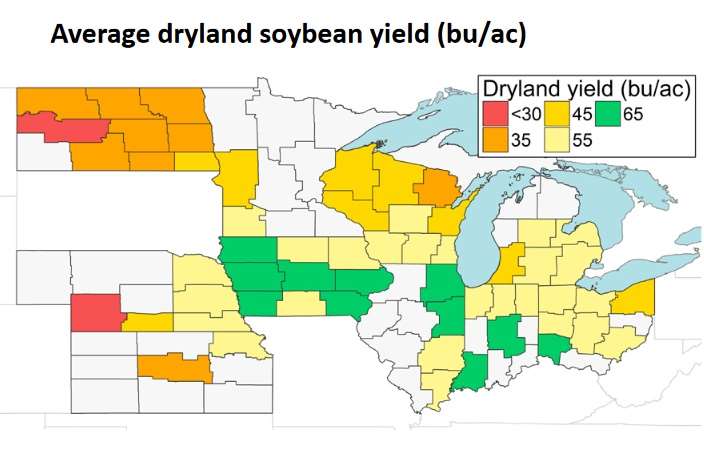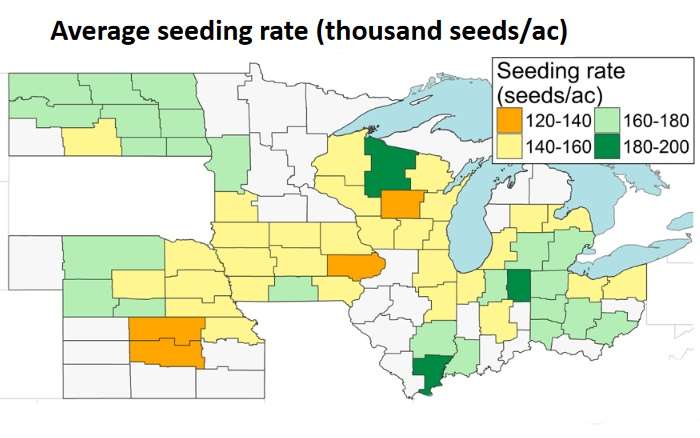By Patricio Grassini
The United States is the largest soybean producer in the world, accounting for 35% of total production. The North Central Region accounts for 80% of US soybean production. We have started a three-year project, funded by the Nebraska Soybean Board and the North Central Soybean Research Program (NCSRP), to identify the key factors that preclude soybean producers from obtaining top yields that should be possible on their individual farms.
Last winter, we collected data from fields planted with soybean in 2014 and 2015 from 10 states in the north-central region (Illinois, Indiana, Iowa, Kansas, Michigan, Minnesota, Ohio, Nebraska, North Dakota, and Wisconsin). Producers completed surveys to provide information on 3,500 fields. A summary report, Benchmarking Soybean Production Systems in the North-Central USA, shows soybean yield and management practices in soybean fields in Nebraska and the rest of the north-central US.
Put Your Soybean Fields on the Map
Locations of Nebraska soybean fields currently in the study. Add data from your fields to this benchmark study by completing the survey described in this article for up to four of your soybean fields.
Find more maps and charts illustrating various aspects of soybean production and management across 10 north central US states in this report summary, Benchmarking Soybean Production Systems in the North-Central USA. In Nebraska for 2014 and 2015 data from a total of 924 soybean fields was added.
Some interesting findings are:
- Nebraska average dryland and irrigated yields were 56 bu/ac and 67 bu/ac respectively, both above the average soybean yield in the north-central region (54 bu/ac).
- Only a small proportion of producers (2%) attained soybean yields near or above 80 bu/ac.
- Half of the soybean area in the north-central region is no-till. Adoption of no-till in Nebraska is greater in dryland (77% of fields) than in irrigated fields (51% of fields).
- About 25% of soybean fields in this region are planted during the first week of May or earlier. This figure rises to 45% in Nebraska.
- Seeding rates used by producers are well above economically optimal soybean seeding rates, which, in the case of Nebraska, is 120,000 seeds/acre. (Also see On-Farm Research Network Soybean Seeding Rate Findings.)
- Most producers in the region grow soybean at a 15-inch row spacing, except for Nebraska and eastern Iowa where 30-inch spacing still prevails.
- Across the entire north-central region, 8%, 19% and 24% of soybean fields are treated with foliar fungicide only, insecticide only, and both fungicide and insecticide, respectively. In Nebraska, these figures are lower at 6%, 3% and 17%.
- About 15%, 54% and 54% of fields in the north-central region received starter, phosphorous, and potassium fertilizer, respectively. In Nebraska, these figures are 15%, 70%, and 54%.


Data from 2014 and 2015 paints a picture of many aspects of soybean production in the north central region. Now researchers are asking producers to contribute data from their 2016 production cycle to help identify factors keeping individual fields from reaching their full yield potential. See this week's story for how you can participate in this benchmark soybean study and put your field on the map. Also find more maps illustrating what they've learned in the first two years of this study.
Here's How You Can Become Part of This Soybean Study
Researchers at the UNL Department of Agronomy and Horticulture and specialists and educators in Nebraska Extension and Nebraska Natural Resources Districts (NRDs) will be collecting soybean field data again this winter. We are asking Nebraska crop producers to provide us with yield and other agronomic data specific to their fields planted with soybean in 2016. With this data, we can conduct an in‐depth analysis of what on‐farm factors might be limiting soybean yield in your fields.
Here is your opportunity to contribute to the project! Download and complete the fillable-PDF survey. Specifically, we are requesting yield and management data specific to four fields of soybean that you grew on your farm in 2016. Both dryland and irrigated fields are acceptable.